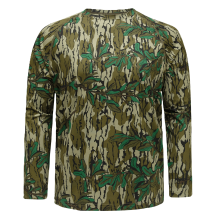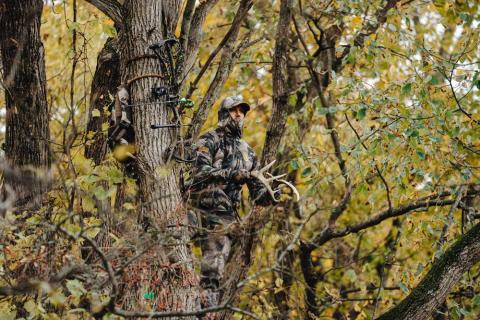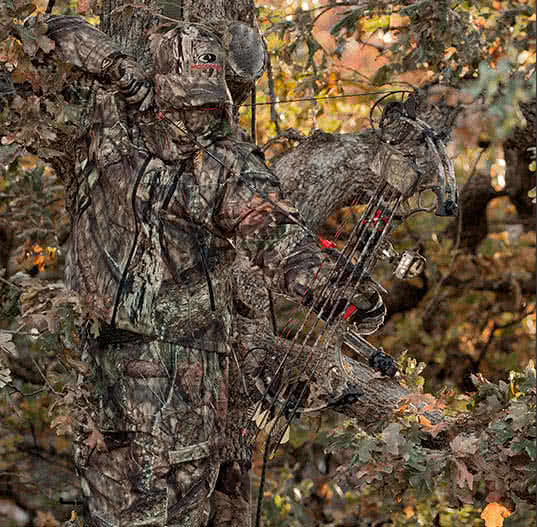Heath Wood
September marks the official start of deer season in many states, and for hunters, it’s a month full of opportunities. Unlike October, when changing weather, hunting pressure, and shifting food sources can make deer harder to predict, September is one of the most reliable times to hunt whitetails. Bucks are still in their late-summer patterns, and if you can identify the right food source, you’ll be in control.
In late September of 2023, while scouting and hiking to a few of my early-season stands, I noticed the woods were loaded with acorns. In some spots, they were so thick on the ground that every step crunched and rolled beneath my boots. Most of the crop that year was concentrated on three or four long ridge tops, which is precisely where I spent the bulk of my September and October hunts.
By the time the rut kicked in at the end of October, does were hammering those acorns, and naturally, a few bucks stayed close, keeping an eye on them to see if any were ready to breed. With the acorns drawing so many deer into the same area, it wasn’t long before I got my chance. I ended up tagging a mature buck just a week later, right after he crossed the ridge chasing a hot doe. It proved once again that if you find the food, you’ll find the does and the bucks won’t be far behind.
Green Food Sources and Mast Crops

In the early fall, deer are drawn to green food sources, such as alfalfa, clover, and young soybeans. These fields provide the protein bucks need as they shed their velvet and prepare for the rut. Around the same time, mast crops, especially white oaks, start dropping acorns. When that happens, deer don’t waste any time shifting their patterns to take advantage of the easy food. Just like I experienced with my buck a couple of seasons back, hunters who pay attention to which trees are dropping and locate spots where the ground is littered with deer’s favorite natural food can put themselves at a real advantage.
Ag Fields and Predictable Patterns
Agricultural fields play a significant role in September deer hunting. Corn, soybeans, and milo offer dependable feeding areas that attract deer day after day. Especially in the evenings, hunters can expect deer to gather in nearby cover before moving into these fields, often along the same trails or field edges. That’s why many hunters prefer to use a hang-on stand or tree saddle to stay hidden twenty or thirty yards inside the cover, waiting for deer to transition from cover to food. The last few minutes of daylight are often when many hunters have taken mature bucks, just before they head out into the open fields to feed for the night. Unlike the unpredictable patterns of October, these behaviors tend to stay consistent until increased pressure causes them to change, and they enter the first pre-rut phase.
Setting Up With Minimal Intrusion
One of the keys to capitalizing on September food sources is hunting with minimal intrusion. Deer at this time of year are on a tight schedule, and a single bad encounter can push them into nocturnal patterns. When setting a stand, tree saddle, or blind, it’s critical to consider wind direction, access routes, and concealment. Slip in quietly with as little ground scent as possible and focus your hunts on evenings when deer are most likely to enter food sources before dark. Morning hunts can work near bedding areas, but they carry a higher risk of bumping deer on the way in and should only be done if that is the only time the hunter has available time to hunt.
Timing the Hunt

September isn’t the month to be overly aggressive. A carefully chosen hunt or two during prime conditions can be more productive than hunting every chance you get. In the early season and throughout October, the HuntStand app is one of my most effective tools. I always keep an eye on my activity forecast on the app, which can forecast up to fifteen days in advance. Each day, I’ll check the forecast and wait for the right wind, a cool front, or the best days to see a mature buck. Besides weather and other natural elements that can affect deer movement, pay attention to changing food preferences, and strike when confidence is high. Again, if you spook a deer out of its tight core area during the early part of the season due to the wrong wind or other factors, you risk pushing the deer out of its regular travel route or out of the area for good.
The September Advantage
September is one of the best times to get a jump on whitetails. Bucks are still fairly relaxed, food sources are consistent, and their daily routines haven’t been thrown off yet. If you focus on green fields, mast crops, or agricultural fields and slip in with a careful setup, you’ve got a real shot at tagging a mature buck before the more challenging hunting conditions of October set in. A lot of hunters dread mid-October, calling it the “October lull,” because the deer they’d been spotting in fields or other open areas suddenly seem to disappear. In reality, I think this shift happens when deer key in on mast crops, especially oak acorns. Hunters who stay adaptable and follow those changes in movement and wait for the right conditions can find early fall to be one of the best times to tag a mature buck.






























